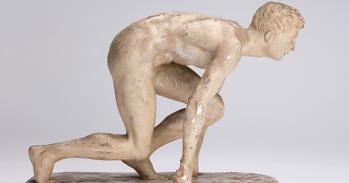
The genuine scientific benefits that have emerged from the modern Olympic Games have often been lost in the hype surrounding these high profile international events. Dr Vanessa Heggie, a Teaching Associate in the Department of History and Philosophy of Science, puts the record straight.
The genuine scientific benefits that have emerged from the modern Olympic Games have often been lost in the hype surrounding these high profile international events. Dr Vanessa Heggie, a Teaching Associate in the Department of History and Philosophy of Science, puts the record straight.
For more than a century, the Olympic Games have provided the inspiration, support, and subjects for thousands of clinical and scientific studies.
As the costs of hosting the upcoming Olympic Games spiral upwards, there is growing concern about the Olympic ‘legacy’. Will Britain as a whole benefit from the 2012 Games - or will the benefits, if there are any, be confined to London? Most of the discussion focuses on the physical and financial legacy of the Games: the new buildings, improved transport infrastructure and influx of tourist money. Some has considered less material consequences, such as the possible health benefits the Games might bring in inspiring the nation to take up a more active lifestyle, but other legacies have often been under-reported.
What might be surprising is how much scientific research is inspired by the Olympic Games. My work has shown that some of the most overlooked legacies of the Modern Olympic Games are those in the realms of science and medicine. It is easy, when we are interested in amateur performers and natural talents, to ignore the scientific and medical professionals working behind the scenes. In fact, modern sport and modern experimental medicine have enjoyed a close relationship since the end of the 19th century. Athletes are, after all, useful experimental subjects – where else could you find clinical volunteers who are willing not only to have their blood taken, but also to run for more than two hours?
The first modern Olympic Games took place in 1896, in Athens. It was the inspiration for many other sporting events across the world, including the Boston Marathon, which was first held in 1897 and is now the oldest continuously-held marathon event. The Boston Marathon has attracted an extraordinary amount of medical attention. In 1899 several doctors from the Tufts Medical School performed respiratory and cardiovascular examinations of the entrants, concluding that long-distance running was a safe and healthy sport for robust young men. Between 1900 and 1903 a host of doctors performed more intensive studies – including weighing the competitors and examining their urine under microscopes – drawing conclusions about general human metabolism and health, and making suggestions for changes to military training and practice (particularly in relation to long-distance marching).
Olympic marathoners were first examined in 1908, when the London organising committee introduced medical checks, insisting that entrants to the marathon should bring a certificate or be examined by doctors. The committee also introduced the first Olympic dope ban. Similar checks were brought in for cyclists in 1912, but these examinations were to protect the health of the athletes, by looking for undiagnosed heart disease, rather than to produce scientific conclusions. The first serious research took place in 1928, when the Games were held in Amsterdam. This was a notable year for sports medicine in Britain as well as internationally; it was in 1928 that the British Olympic Association (BOA) first officially appointed a team doctor, Mr A L Baley. Adolphe Abrahams, brother of the famous sprinter Harold Abrahams, had already become the doctor for the athletics squad, and the boxers brought their own medic, Dr J Wyatt.
In 1928, at the Winter Games in St Moritz, a meeting of doctors from Olympic nations founded the Association Internationale Médico-sportive (AIMS), which changed its name in 1934 to the Fédération Internationale de Médicine Sportive, and remains the major international sports medicine organisation. The first President of AIMS, physiologist Professor Buytendijk, arranged for an international team of doctors and scientists to examine the athletes at the 1928 Summer Games. Among them were Crighton Bramwell and Reginald Ellis from Manchester, who examined the hearts and pulses of runners, cyclists and weightlifters. Bramwell and Ellis noticed that marathon runners had exceptionally stable resting pulse rates – something we now attribute to the high fitness level the marathon requires, but which they suggested might be because of the phlegmatic temperament of the marathoner, compared to the more ‘highly-strung’ sprinters.
It was through examinations like these that the extraordinary nature of the elite athlete became apparent – unusually low resting heart rates, massive lung capacities and phenomenal muscle development. This was obviously important for further work in sports science and medicine, but also contributed insights into the metabolism and medical needs of the general population.
When, in 1948, Britain hosted the Olympics for a second time in London, the country was under the ration book. Much ink was spilt over the problem of feeding the visitors and athletes, and there were fears that the long-term under-fed British population would perform badly compared to teams coming from nations which had not been rationed. Eventually, athletes were given special dispensations to consume more calories than the average physical labourer, and special restaurants were set up to provide the extra food (some of which was donated, including deliveries of fresh fish from the British Trawler’s Association). The Nutrition Society organised a special conference in 1948, which included a panel dedicated to the athletic diet. The discussions about the relative merits of high-protein, high-fat or high-carbohydrate diets, and the nutritional work this inspired, had an impact on general dietary advice, research into diabetes, and innumerable other areas of food science.
The Nutritional Society’s panel noted that athletes were rather suspicious people; they favoured a traditional high-protein diet, despite the scientific evidence that it was carbohydrates which offered a sporting advantage. The ‘psychological factor’ in sporting success became a real bone of contention between scientists and sports authorities in the 1960s, when both began to worry about the effects altitude might have on performance. The 1968 Olympic Games were awarded to Mexico City, which at 7,500 feet above sea level is at mid-altitude, high enough for some visitors to experience the symptoms of low barometric pressure. What would the effect be on athletes? To answer this question the British Olympic Association (BOA) organised, for the first time, its own scientific expedition.
At a cost of £5,000 (something like £150,000 in today’s money) the BOA collaborated with the Amateur Athletic Association, and co-funders the Medical Research Council and the newly-founded Sports Council to send a physiologist (Dr LGCE Pugh), BOA representatives, and six athletes to Mexico, to discover what effects altitude would have on performances. What became clear was that some high-profile events might be positively affected, as the lower air resistance improved performances; on the other hand, endurance events would be negatively affected by the lower oxygen partial pressure in Mexico City. Athletes would also have to acclimatise to altitude, which would be difficult because the amateur rules of the International Olympic Committee (IOC) were strict about how long athletes could spend in intensive ‘training camps’ (in the end the research from Britain and other countries persuaded the IOC to increase the maximum time from four to six weeks). The BOA was pretty sanguine about the ability of their athletes to acclimatise, but was worried about the overexcited coverage in the media; Gold medal winner Chris Brasher claimed in the Observer that some athletes might even die in Mexico. Because it was believed that some athletes could suffer psychosomatic altitude sickness and performance problems, the BOA needed to produce a convincingly objective and scientific report on the altitude problem.
With increasing security at Olympic Games, it has become far less common for research to take place at the Games themselves. However, the events have continued to prompt research, while sports organisations have continued to fund scientists in their work. When we think of sports medicine and the Olympics, the topics that spring most readily to mind are drugs and sex testing scandals. Here too there is a legacy beyond the headlines: sensitive drug tests are used outside sports too, and research into intersex and gender identities has been – at least in part – informed by the experience of sports authorities and their sex testing regimes. For more than a century, the Olympic Games have provided the inspiration, support, and subjects for thousands of clinical and scientific studies. From cardiology and nutrition to genetics and biomechanics, scientific innovations have started with an Olympic event. The Olympic science legacy has probably affected all of us far more than a glamorous new stadium or a healthy eating campaign ever could.
Vanessa Heggie is author of A History of British Sports Medicine (Manchester University Press, 2011). She is currently working on two other books – one on how athletes have been used in scientific experiments, and the other on the history of scientific expeditions and exploration physiology.
This work is licensed under a Creative Commons Licence. If you use this content on your site please link back to this page.





